Discover top guides, trends, tips and expertise from AIO Writers
How to Curate Content: A Comprehensive Guide for Marketers
Julia McCoy
Tuesday, 11th Jul 2023
A savvy marketer wears many hats: content creator, content distributor, social media marketer, email marketer, list builder — the list goes on.
Creating blog content alone takes up so much time, and 55% of marketers have small teams devoted to content creation.
We all know that it takes hours or even days to write in-depth content from scratch, but most businesses just don’t have the budget to add more writers to their workforce.
So what do you do?
Content curation is the perfect solution to this problem. The key is finding the best sources to share with your audience.
How do you know it works?
85% of B2B content marketers admit to relying on content curation for their organization’s success.
And 57% of marketers feel that content curation is the best way to regularly produce fresh content.
But how to curate content successfully?
We’ve created this guide to help you learn how to curate content for maximum impact.
We’ll teach you how to understand your target audience‘s preferences so you can find the best content for them.
We’ll also introduce you to tools that can help curate content effectively, plus examples of successfully curated pieces.
Let’s dive right in!
Table of Contents:
- What is Content Curation?
- Benefits of Content Curation
- How to Curate Content
- A Step-by-Step Guide on How to Curate Content
- Finding the Right Content for Your Audience
- Finding the Right Tool for Content Curation
- Examples of Content Curation
- How to Repurpose Curated Content
- The Role of Microsites in Maximizing Reach
- Be a Regular Content Curator
What is Content Curation?
Content curation is the process of sourcing, selecting, and sharing high-quality digital content that resonates with your target audience. It’s a strategy used by many successful content marketers today.
When you curate content, you become like a museum curator who carefully selects pieces to display in an exhibition. In this case, the “exhibition” could be on social media platforms or blog posts on your website.
Why curate content?
Curating content allows brands to provide value beyond their own content. By sharing relevant news articles, blogs, and other curated pieces from credible sources within your industry, you demonstrate not only knowledge but also engagement with wider conversations happening in your niche.
Benefits of Content Curation
Content curation is a vital part of any successful content marketing strategy. It involves the process of finding, organizing, and sharing relevant content from various sources on your social media platforms or blog post.
Here are some benefits that come with curating content:
Become a Go-To Resource for Your Audience
The primary benefit of curated content lies in its ability to transform your brand into an informational hub. When you curate information from various sources across the web, your platform becomes a one-stop shop for all things related to your niche. This convenience makes it more likely that users will choose you over competitors when seeking relevant content.
Maintain Freshness and Variety
Audiences crave variety. Sharing curated content from different sources ensures that there’s always something new for them to consume on your platforms. With this approach, monotony takes a backseat as fresh perspectives keep followers engaged and interested.
Save Time and Effort
Curating content can save you time and effort compared to creating content from scratch. It allows you to increase the volume of shared content while freeing up resources for other aspects of your business.
Foster Exploration and Validation
Curated pieces allow you to explore topics that may not have been on your radar initially. This exploration helps in discovering new interests within your target audience and validating their preferences in the process.
Promote Unique Perspectives
If a curated piece resonates well with your audience, it might inspire you to conduct further research on the topic and share unique perspectives through created content.
Elevate Your Authority Status
In today’s digital age where there’s an overload of information available online, being able to sift through irrelevant data and present only useful insights increases trust among readers. They’ll perceive your brand as an authority figure that provides value-added services.
Increase Post Frequency with Minimal Effort
Social media platforms demand regular updates — often multiple times per day! Curated content can help meet these demands without significantly increasing workload or compromising quality. By finding engaging articles or blog posts written by others (and giving due credit), brands can easily share valuable insights with their audiences regularly.
This process also helps streamline social media management. Instead of scrambling last minute for post ideas, content curation allows teams to plan ahead using tools like content calendars.
How to Curate Content
Content curation is a strategic approach that can augment your original work. However, it’s crucial to do this correctly to avoid creating duplicate content, which could negatively impact your SEO.
The first step in any content curation strategy is attributing credit where it’s due. Always give credit to the original author or site from where you curated the information. This not only respects intellectual property rights but also ensures that search engines don’t flag your website for plagiarism.
Remember: Your aim should be curating content with your target audience in mind rather than merely pleasing search engines.
Mixing original and curated content ideas adds uniqueness to your website while maintaining relevance for readers. Like a museum curator selects artifacts carefully, so should you select relevant articles or blog posts from various sources. Over-reliance on one source might encourage users to visit that other site directly next time!
To sum up, when done well, curated content adds value to your online presence without diluting your SEO efforts.
Creating and Curating Content – The Winning Combo
A common misconception among many budding content marketers is that content curation has become obsolete, which is far from the truth! Well-thought-out, unique ideas presented in an innovative way still have immense potential as traffic-driving tools.
In any content marketing strategy, both created content and curated content are essential ingredients for success. Their combined effect can create an impactful experience for audiences across different social channels.
Keep sharing valuable curated content pieces but remember: they’re there to complement your own thoughts and insights rather than replace them entirely. Maintain a healthy balance between what you find interesting out there versus what unique perspectives you bring forth as part of your overall content strategy.
There are three basic steps in how to curate content:
- Find relevant content: Use search engines and follow influential people within your industry to find interesting and valuable information for curating content.
- Select great content pieces: Choose content pieces that align well with your audience’s interests while reinforcing the image of your brand as an expert in the field.
- Share content: Share these content ideas across various social channels where they will reach maximum viewership.
A robust content curation strategy requires careful planning. This helps ensure that there’s always fresh material ready for distribution while maintaining consistency in quality and relevance.
Last but not least:
Remember the Golden Rule of Sharing!
When you curate information, always credit original authors/sources. It’s the ethical thing to do and keeps you protected from copyright issues.

Screenshot from Neil Patel
A Step-by-Step Guide on How to Curate Content
1. Create a List of Relevant Reading, Listening, or Viewing
One proven approach to curating content is offering your audience a list of relevant resources that they might find interesting or useful.
Share links to various blog posts and news articles grouped into categories for easy navigation.
For example, under the category “Social Media Marketing”, you may find titles like “What is Social Media Marketing Automation” or “Best Tools for Social Media Marketing.”
The goal is to help your audience with what they want to know. If someone has already created content that answers their questions effectively, don’t hesitate to share it in your curated lists. Your target audience will appreciate you saving them time in finding the information they need.
2. Write an Original Article Based on Existing Content
Creating compelling and relevant content is a key aspect of any successful content marketing strategy. One effective way to do this is through content curation.
A prime example can be seen in how Influencer Marketing Hub curated several research-based articles from Sprout Social, Buffer, and CoSchedule to create an original piece titled “The Best Times To Post on Facebook.” This approach not only allowed them to share valuable insights with their target audience but also demonstrated the power of leveraging existing resources.
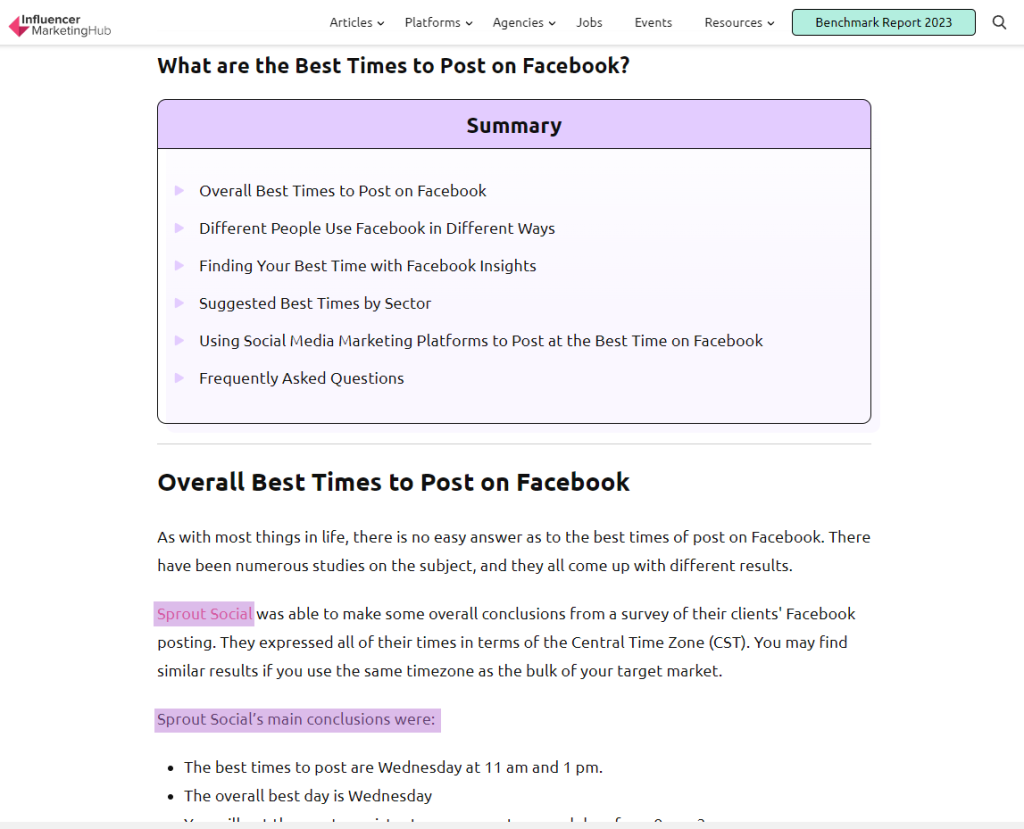
Screenshot from Influencer Marketing Hub
The bulk of the curated piece relied heavily on the Facebook section of CoSchedule’s blog post: “The Best Times to Post on Social Media.” They even incorporated CoSchedule’s original graphic showing recommended Facebook posting times into their own work.
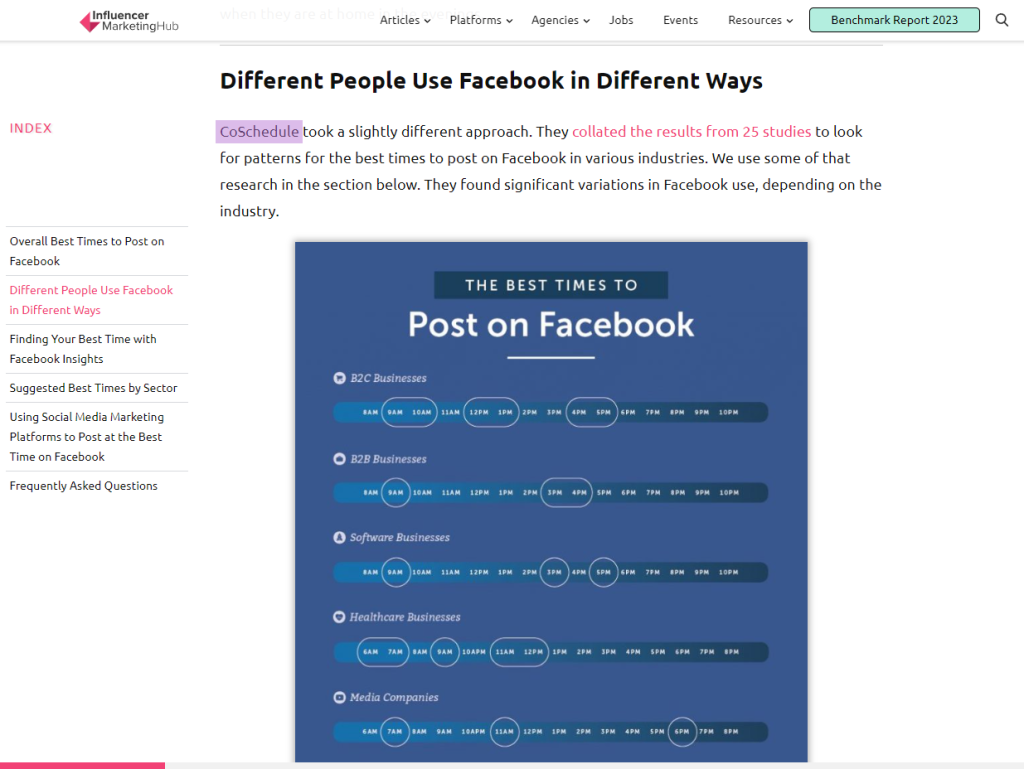
Original research makes great fodder for curating content. By sharing the most pertinent insights with your audience, you’re able to build upon someone else’s work while still providing unique value.
Just make sure you always link back to your sources and mention them in your content to avoid potential plagiarism issues. (Influencer Marketing Hub did this well in their post, so if you’re not sure how to go about linking/mentioning sources, study that blog as an example. You can also read our guide on fact-checking for help on where to find good sources to use in your article.)
3. Simplify Social Threads with Curation
In today’s digital world, you can’t underestimate the power of social media. Brands and content marketers alike are leveraging these platforms to curate information and engage their target audiences with relevant content.
A perfect example is TLDR Crypto, a brand that has mastered the art of simplifying complex Twitter threads into bite-sized curated pieces for its newsletter subscribers. By doing so, they not only share content in an easy-to-digest format but also provide valuable insights from across various social channels.
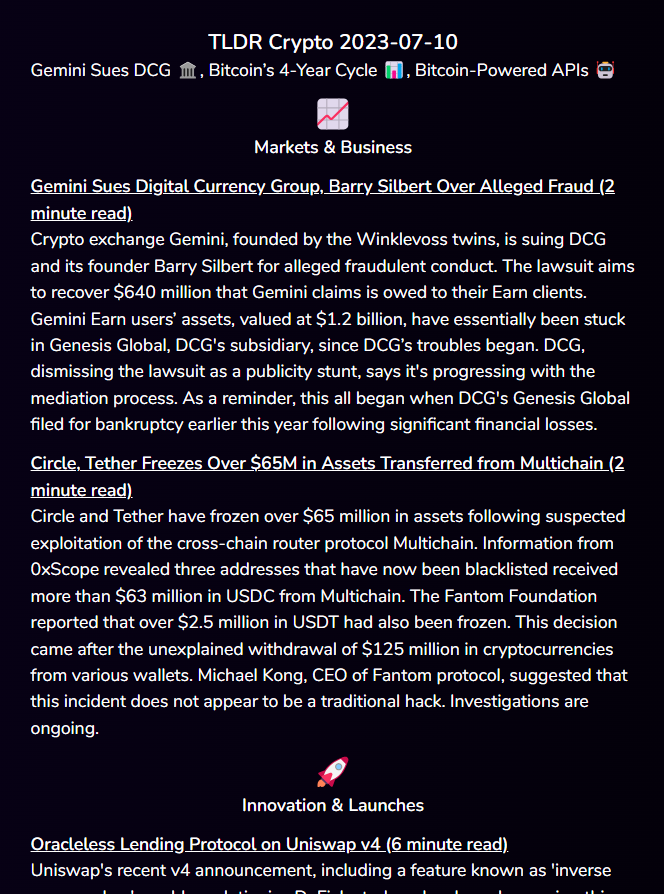
Screenshot from TLDR Crypto
This process starts by identifying engaging threads on topics relevant to their audience. Then they distill the key points from each thread along with a brief background explanation. This created content is then shared through newsletters, making it easier for readers who may find it challenging to keep up with all the happenings on social media.
There’s no shortage of insightful discussions happening every day. Your job as a curator is to sift through them and select those most pertinent to your followers’ interests.
Start by keeping an eye out for trending conversations within your industry or niche area – these could be potential gold mines for curation-worthy material! Once you’ve identified some promising candidates, work on summarizing them into concise summaries that convey the main ideas without overwhelming readers with excessive detail.
4. Combine Multiple Sources
When curating information, it’s important to cast a wide net and bring together diverse sources for your curated pieces.
Let’s take an example from The Newsette, a daily news email that empowers women through its curated content. Their strategy involves taking a theme or topic and sourcing information from various outlets to develop it fully.
For instance, in one of their entries on fitness, they used several references ranging from national media like The New York Times to niche blogs such as “She’s a Beast: A Swole Woman’s Newsletter.”
Don’t limit yourself to traditional media alone. Depending on your niche, solo bloggers, local media outlets, and even academic journals can provide relevant insights both within and outside your niche. By diversifying your sources, you provide room for unique storytelling methods that could captivate your audience.
Your aim when compiling this wealth of knowledge should be more than just filling up space on your site or social media platforms. Each piece must serve specific purposes set by your content marketing team. Whether you’re trying to educate users about new developments or challenging existing notions, always curate with intent!
5. Go Deep on a Topic
Curating content isn’t just about gathering information from various sources. It’s also about digging deeper into a particular subject matter to provide your audience with comprehensive insights. One of the most effective ways to curate content is by focusing intensely on a single topic and providing in-depth analysis.
A perfect example of this approach can be seen in The Profile by Polina Pompliano, where she maximizes her curation process for all things related to the most successful people and companies — everyone from celebrities to top chefs to innovators and world-changers. In addition to a feature story (The Profile Dossier), she curates additional content pieces relevant to the person she’s profiling that might interest her readership.
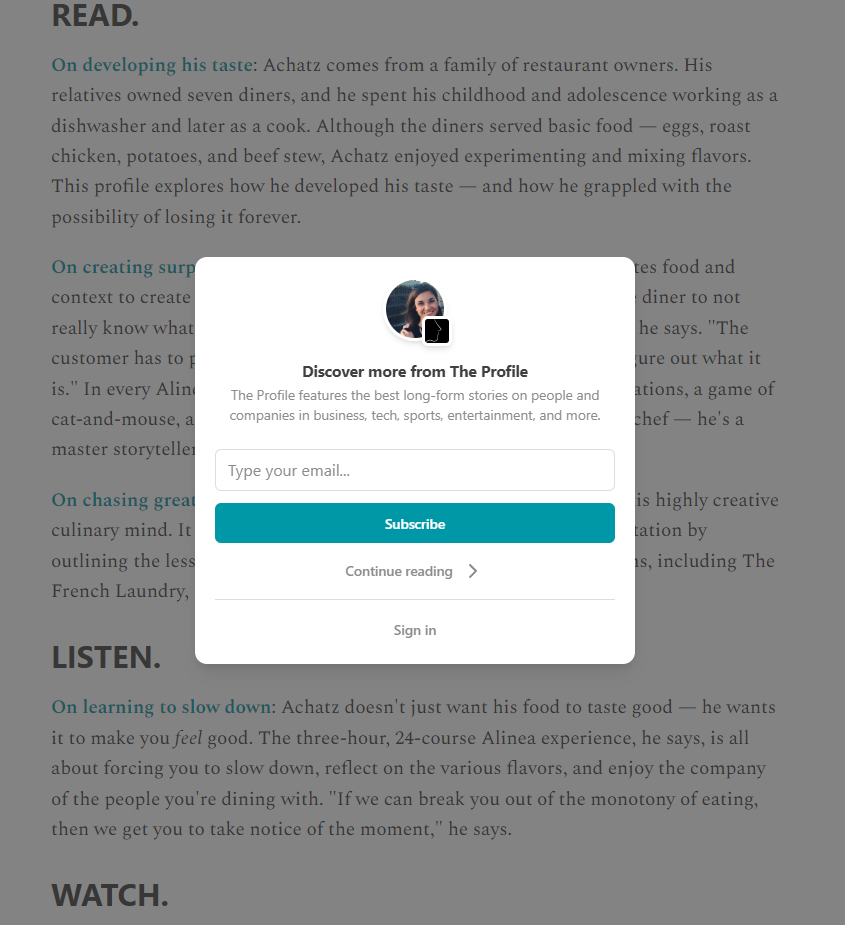
Screenshot from The Profile
6. Curate Content from Your Archives
Content curation is also a way to breathe new life into your created content. A master of this approach is Jodi Harris, director of content strategy at Content Marketing Institute, who regularly crafts fresh articles by integrating insights and examples from her previous works and those of other contributors.
An example is her recent article “9 Visual Tips and Examples From Creative Brands and Experts” where she pulls together tips from various published pieces.
Similarly, if you’ve been publishing content for a while, you’ve likely generated a significant amount of content across different formats on similar broad topics over time. Curating such material allows you to pull together the most relevant points to craft an original piece that provides value to your audience while saving resources.

How automated content curation works
More Tips on Finding the Right Content for Your Audience
To curate content effectively, you need to understand your audience’s needs and preferences. This requires regular interaction with them through comments, likes, shares, and other forms of engagement on social channels.
You can also use analytics tools to gain insights into their behavior patterns online. Analytics tools provide valuable data about what type of curated pieces resonate most with your audience.
A well-planned content curation strategy can help streamline the process of discovering high-quality content ideas that align with your brand values.
- Start by setting clear objectives for what you want to achieve through curating content.
- A content calendar helps organize created or curated pieces in advance so that they are ready for posting when needed.
- Curate information only from reliable sources. Sharing inaccurate information could damage your credibility as an expert in your field.
- While it’s important to share relevant news articles or blog posts from industry leaders, remember not to overdo it. Strive for a balance between original and curated material.
- Promote curated pieces across multiple platforms: Your audiences may be scattered across different social media sites like Facebook or Twitter so ensure that you’re present where they are.
- Mix up formats when curating content. Beyond simply repurposing text-based posts, consider how you could curate information across mediums too. For instance, insights gleaned from several blog posts could be transformed into an engaging podcast episode or social media infographic.
Remember, the goal isn’t just gathering tons of random information but rather providing value-added resources that cater specifically to the interests/needs of your audience. This will help build trust and loyalty and ultimately result in increased conversions, revenue growth, and overall success.
Finding the Right Tool for Content Curation
The process of content curation can be quite challenging without the right tools to curate information effectively. The good news is that there are resources specifically designed for this task.
Curating content through Flipboard involves gathering and organizing articles, blog posts, videos, and other web content from various sources into personalized collections called “magazines.”
Flipboard uses algorithms to analyze your interests and browsing behavior to provide personalized content recommendations. It suggests articles, blogs, and websites that align with your preferences, making it easier to discover relevant content for curation.
There are three ways to find content to add to your Flipboard magazine:
- Explore topics: Use the search bar or browse Flipboard’s categories to find articles, blogs, and websites related to your interests. Follow specific topics to get curated content recommendations.
- Add social media accounts: Connect your social media accounts (such as Twitter, Facebook, and Instagram) to Flipboard. This allows you to curate content from your social feeds and share them in your magazine.
- Use the Flipboard bookmarklet: Install the Flipboard bookmarklet on your web browser. When you come across an interesting article or webpage, click the bookmarklet to add it to your magazine.
Flipboard aggregates content from a wide range of sources, including major publications, blogs, social media accounts, and RSS feeds. You can create personalized magazines based on specific topics or themes and share individual articles or entire magazines, extending the reach of your curated content.
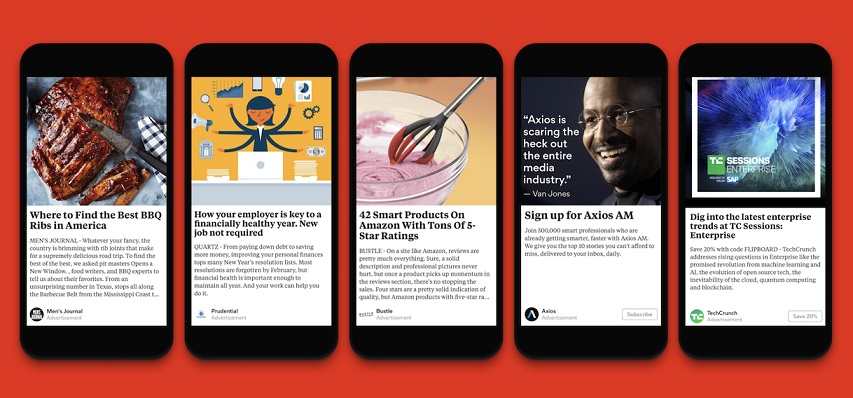
Quuu
Quuu is a content curation platform that helps you discover and share high-quality content on social media. It offers several notable features that make it a popular choice for content curation, including content suggestions, customization and commentary, automated scheduling, and analytics.
Quuu’s content suggestions cover a wide range of formats, including articles, blog posts, videos, infographics, and more. This variety helps you diversify your curated content and keep it fresh and interesting for your audience.
Quuu’s interface is user-friendly and intuitive, making it easy to navigate and manage your curated content. The platform’s design focuses on simplicity and efficiency, allowing you to curate and share content seamlessly.
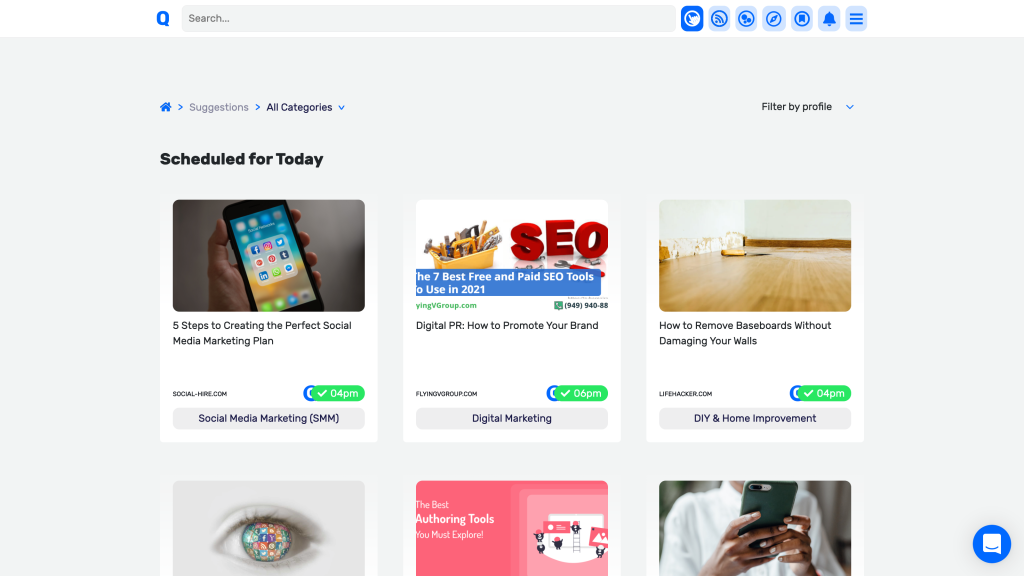
Scoop.it
Scoop.it provides a powerful content discovery engine that suggests relevant content based on your selected topics and interests. It scours the web to find high-quality articles, blog posts, videos, and more, saving you time in the content discovery process.
The platform allows you to create curated boards to organize and display your curated content. You can create multiple boards based on different themes or topics, enabling you to curate and showcase content in a structured and visually appealing manner.
Scoop.it enables you to customize the curated content by adding your own commentary, insights, or context to each item. This customization allows you to provide additional value to your audience and showcase your expertise on the curated topic.
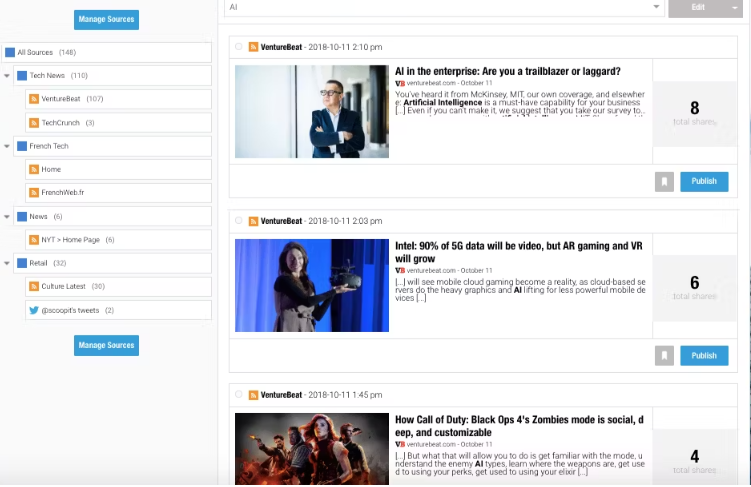
Feedly
Feedly’s Smart Feed algorithm analyzes your reading patterns and preferences to provide personalized content recommendations. It learns from your interactions, such as the articles you save or mark as read, to deliver a curated stream of content that matches your interests.
You can create collections or boards to organize your curated content based on specific themes or categories, making it easier to curate and revisit content later.
Feedly integrates with popular productivity tools like Evernote, Pocket, and OneNote for seamless organization and sharing across platforms.
You can also set up keyword alerts to receive notifications when specific keywords or topics are mentioned in newly published articles, allowing you to stay on top of the latest trends and discover relevant content for curation.
If you are traveling and have limited internet connectivity, you can still use Feedly as it allows you to save articles to read and curate later even when you are offline.
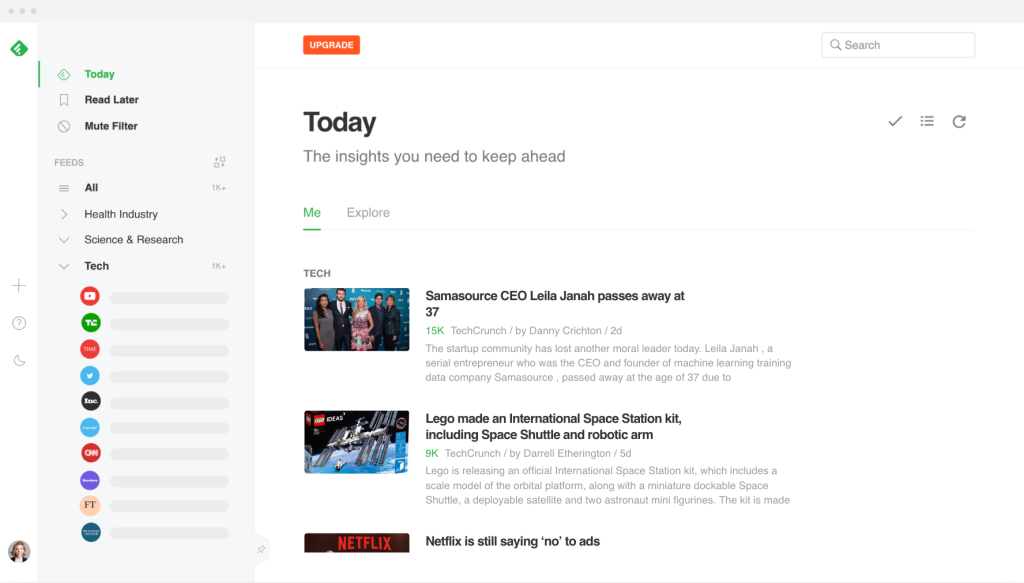
Curata
Curata employs machine learning algorithms to analyze your content preferences, behavior, and engagement patterns. It learns from your interactions to deliver personalized content recommendations, ensuring that the curated content aligns with your interests and audience’s preferences.
With real-time content monitoring capabilities, Curata keeps you updated on the latest content published in your chosen topics, ensuring that you have a fresh stream of curated content to work with. You can set up alerts to receive notifications when new content is available.
Curata allows you to customize curated content by adding your own commentary, annotations, and insights. You can tailor the curated content to fit your brand’s voice and provide additional value to your audience through personalized insights and context.
Automated scheduling makes it easy to set specific dates and times for content distribution, ensuring a consistent flow of curated content to your audience without manual intervention.
Curata also offers features to manage content licensing and ensure proper attribution. This is particularly useful when curating third-party content, as it helps maintain compliance with copyright regulations and ensures proper credit to the original content creators.
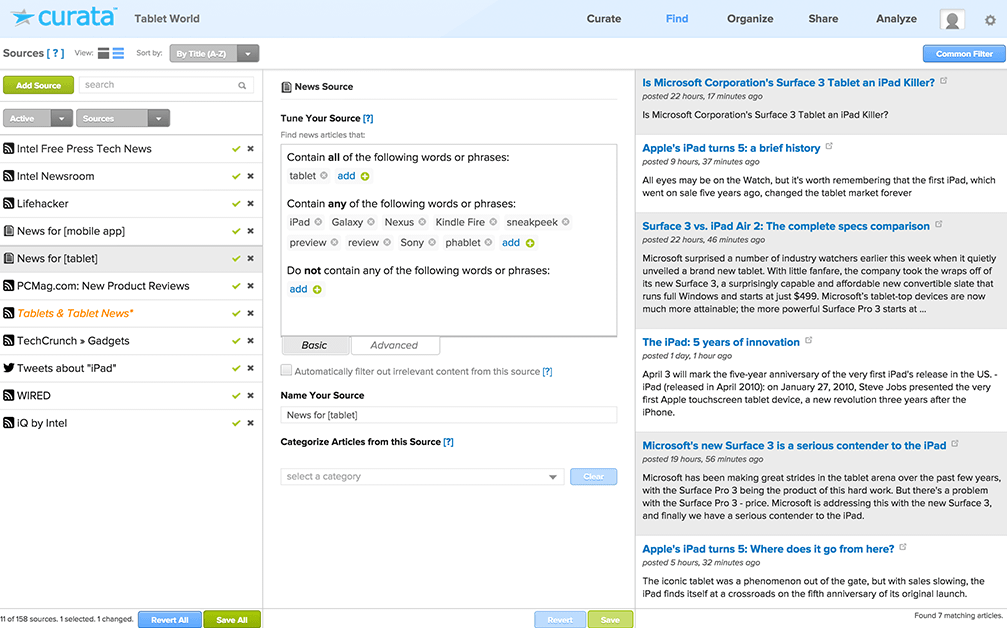
NYTLicensing
One resource for licensed curated content is NYTLicensing. This service provides high-quality curated pieces from renowned publishers, helping position your organization as a thought leader in your field.
Unlike other services that rely on automation to generate suggestions, NYTLicensing offers bespoke solutions tailored specifically to your audience’s needs. Their team assists you in selecting appropriate articles and other forms of created content that resonate best with your social media followers and blog readers.
A copyright license like the one provided by NYTLicensing saves both time and money when repurposing content across different channels. By distributing carefully selected news articles or original content pieces that truly matter to your target audience, you become a trusted source of information in your industry.
Your goal should always be delivering valuable knowledge — not just promoting products or services. You want to establish trust among consumers who will share your content within their networks if they find it useful enough.
Examples of Content Curation
Now let’s take a look at a few successful examples of how content curation has led to business growth.
AdvisorStream
AdvisorStream, an award-winning platform designed for financial advisors, uses licensed content and financial news from reputable publishers to drive engagement with their user base. The company adopted a strategic approach to curating relevant information from sources like Harvard Business Review.
The addition of these carefully selected pieces significantly boosted AdvisorStream’s trusted resources, reinforcing one core value proposition — helping advisors grow their businesses through lead capture. As a result, they experienced a 200% increase in views and a whopping 260% rise in lead capture conversions on their platform after adding curated content.
Estadão.com
Brazilian daily newspaper O Estado de S. Paulo also utilized an effective content curation strategy. They created “Imóveis“, a new section on the Estadão website offering reliable information about all aspects related to home buying – ranging from price negotiation tips to decorating ideas.
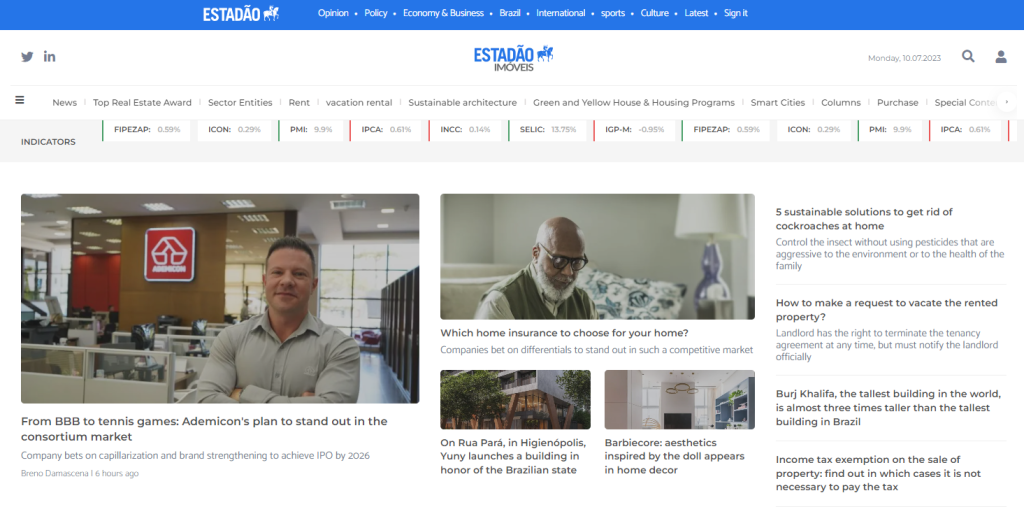
Screenshot from Estadão.com
To build out this section, they published original articles along with licensed ones curated by NYTLicensing which included pieces from renowned sections such as The New York Times Real Estate and Smarter Living along with videos from T: The New York Times Style Magazine. This unique blend not only increased reader engagement but also led users toward other sections on the Estadão site — proving that well-curated content can indeed enhance your overall content marketing strategy.
Almost Timely News
The Almost Timely News newsletter, curated by Christopher Penn from Trust Insights, stands out for its capacity to deliver useful knowledge consistently while still providing readers with new outlooks on popular subjects.
What makes this example successful is its ability to maintain consistency in delivering valuable information while keeping readers engaged with fresh perspectives on trending topics.
The Newsette
Another brilliant example of content curation is The Newsette. This digital media company focuses on educating women about the latest trends in fashion, beauty, career advice, and more through daily newsletters.
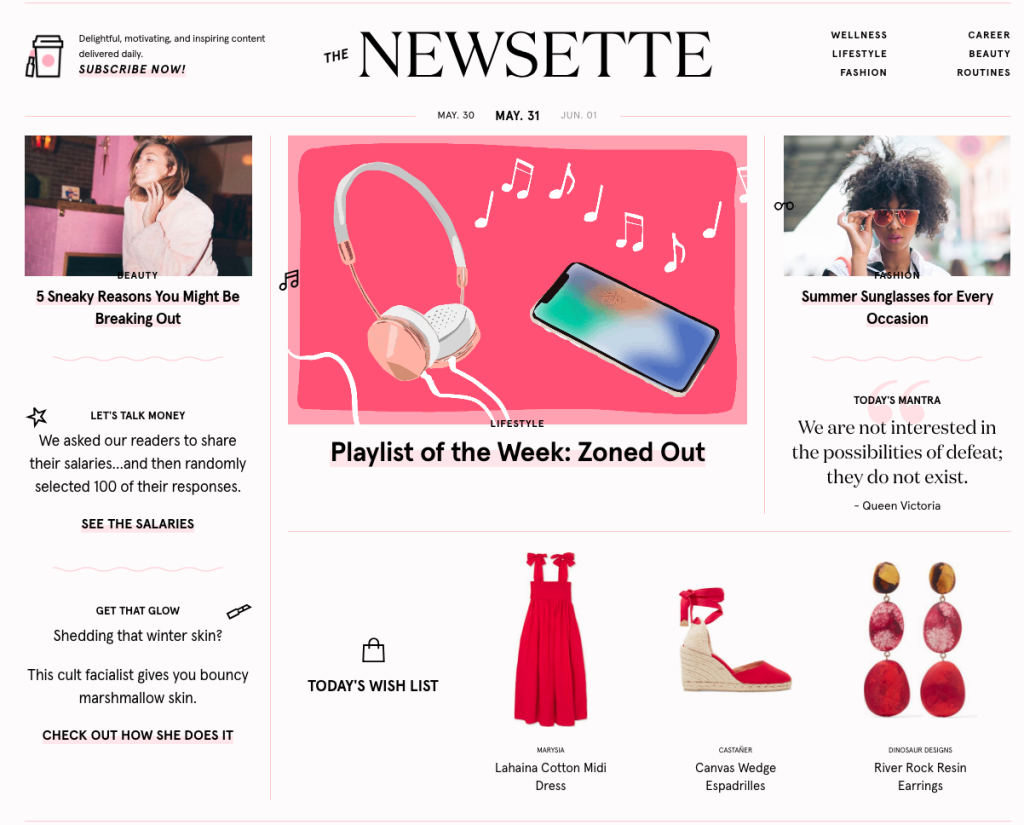
Screenshot from The Newsette
Their approach involves not only sharing original content but also featuring guest posts and interviews with influential figures across different fields.
How to Repurpose Curated Content
Repurposing curated content can be an effective way to extend the lifespan of your existing content and reach new audiences.
Taking your existing content and giving it a fresh spin to re-engage your audience is not just smart — it’s efficient too.
Here are some steps to repurpose curated content effectively:
- Identify the content to repurpose: Review your curated content and identify pieces that have performed well or have the potential to be repurposed in different formats.
- Determine the repurposing goal: Clarify the objective of repurposing the content. Do you want to reach a new audience, increase engagement, drive traffic, or enhance brand visibility? Having a clear goal will guide your repurposing strategy.
- Choose the repurposing format: Consider various formats to transform your curated content. Some popular options include:
- Blog posts: Expand on curated content by adding your insights, analysis, and additional information.
- Infographics: Condense key points and statistics into visually appealing graphics.
- Videos: Create videos summarizing or discussing the curated content, incorporating visuals, voice-overs, or interviews.
- Slide presentations: Convert curated content into a slide deck format, highlighting key points and using engaging visuals.
- Podcasts: Convert written content into audio format, discussing and elaborating on the curated content.
- Social media posts: Extract key quotes, statistics, or insights and share them on various social media platforms to drive engagement.
- Customize the content for the chosen format: Tailor the content to suit the specific format. For example:
- For blog posts: Add a personal story, images, or examples.
- For infographics: Present the main points in visually appealing sections. Use icons, graphs, and charts to illustrate information.
- For videos: Create a script, record your voice, and add visuals, animations, or text overlays to enhance the presentation.
- For slide presentations: Summarize key points, use captivating visuals, and ensure the content flows logically.
- For podcasts: Create an engaging script, record audio, and include relevant discussion points or interviews.
- For social media posts: Condense key insights into short, impactful statements or quotes. Add eye-catching visuals to accompany the text.
- Optimize for different channels: Tailor your repurposed content to fit different platforms. For example, adjust the dimensions and resolution for social media, optimize metadata for SEO, or create engaging thumbnails for videos.
- Promote the repurposed content: Share your repurposed content across appropriate channels, including your website, blog, social media platforms, email newsletters, and relevant online communities. Consider leveraging influencers or collaborating with other content creators to expand your reach.
- Track and analyze: Monitor the performance of your repurposed content, including metrics such as engagement, traffic, shares, and conversions. This data will help you refine your repurposing strategy and identify the most effective formats and channels.
Remember to always provide proper attribution when repurposing curated content and respect any copyright or licensing restrictions associated with the original content.
The Role of Microsites in Maximizing Reach
Microsites, when used strategically, can be a game-changer in content curation.
A microsite is a little webpage that lives within your website, focusing on one specific topic and giving your audience all the juicy details they crave.
Think of it as a niche within a niche, a concentrated hub of information that caters to the interests of your readers.
Unlike your main website, which is a jack of all trades, a microsite is a master of one.
With a microsite, you can dive deep into a subject, providing your readers with comprehensive insights that will make their brains explode with knowledge.
Microsites also help you target specific segments of your audience with laser-like precision.
You can sprinkle targeted keywords all over your microsite, without worrying about messing up your main site’s SEO.
If you do it right, your microsite could skyrocket to the top of search engine results pages, making you the king or queen of that specific subject.
No more wandering through irrelevant sections – your visitors will find exactly what they need, without the hassle.
And guess what? A streamlined user experience means more engagement and more conversions. Cha-ching.
Be a Regular Content Curator
Content curation is an essential part of your content marketing strategy. It involves the process of finding, organizing, and sharing relevant content from various sources on your social media platforms or blog post. By curating content regularly, you can provide value to your target audience while also easing the workload for your content marketing team.
Remember that search engines favor websites that consistently publish fresh and original content — but they’re smart enough to recognize the difference between “fresh” and “original.” Therefore, ensure a balance of both types throughout your content calendar.
By sharing content, you are providing added value to your existing user base and attracting new visitors simultaneously, thereby strengthening your brand reputation across the web and significantly increasing your chances of higher rankings in SERPs.

UNLOCK YOUR POTENTIAL
Long Headline that highlights Value Proposition of Lead Magnet
Grab a front row seat to our video masterclasses, interviews, case studies, tutorials, and guides.



